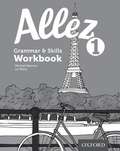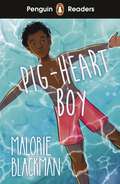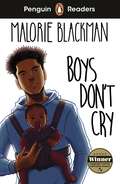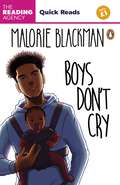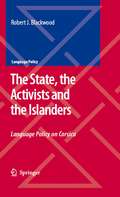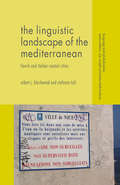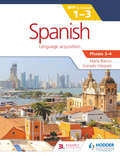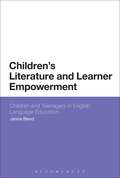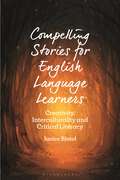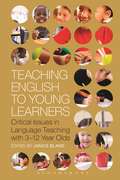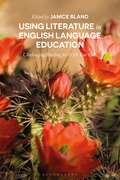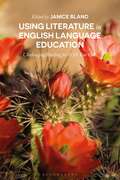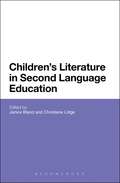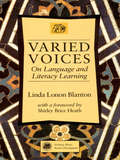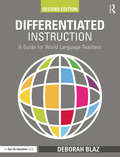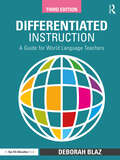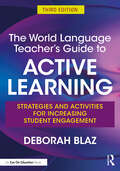- Table View
- List View
Allez Workbook:Grammar And Skills (PDF)
by Liz Black Michael SpencerWith differentiated activities all in one book, Allez is a perfect fit for all your students, no matter what their starting point at grade 6. Allez avoids needless topic repetition and allows more in-depth study and progression with a clear route through for students following a two or three year course. Allez is packed with activities set in real contexts that are close to students' own interests to maintain motivation. The Grammar and Skills Workbook is full of extra practice activities to reinforce and support the grammar and language learning skills covered in the Student Book. It is ideal for homework and further practice either during or outside of lesson time. The Allez course has a full suite of resources to support your needs: the Student Book, Teacher Handbook, Grammar and Skills Workbook, Audio CDs and next generation Kerboodle. Differentiation is provided throughout the Student Book and via Kerboodle.
Penguin Readers Level 4: Pig-Heart Boy (ELT Graded Reader)
by Malorie BlackmanPenguin Readers is an ELT graded reader series. Please note that the eBook edition does NOT include access to the audio edition and digital book. Written for learners of English as a foreign language, each title includes carefully adapted text, new illustrations and language learning exercises.Titles include popular classics, exciting contemporary fiction, and thought-provoking non-fiction, introducing language learners to bestselling authors and compelling content.The eight levels of Penguin Readers follow the Common European Framework of Reference for language learning (CEFR). Exercises at the back of each Reader help language learners to practise grammar, vocabulary, and key exam skills. Before, during and after-reading questions test readers' story comprehension and develop vocabulary.Pig-Heart Boy, a Level 4 Reader, is A2+ in the CEFR framework. The text is made up of sentences with up to three clauses, introducing more complex uses of present perfect simple, passives, phrasal verbs and simple relative clauses. It is well supported by illustrations, which appear regularly.Cameron Kelsey is 13 years old. He is not well and needs a new heart. Doctors want to give him a pig's heart. Cameron cannot decide if he wants the pig's heart, and some groups are very angry about doctors using animals in this way.Visit the Penguin Readers websiteRegister to access online resources including tests, worksheets and answer keys. Exclusively with the print edition, readers can unlock a digital book and audio edition (not available with the eBook).
Penguin Readers Level 5: Boys Don't Cry (ELT Graded Reader)
by Malorie BlackmanPenguin Readers is an ELT graded reader series, for teenagers and young adults learning English as a foreign language.· Carefully adapted text.· Accompanying audio with the print edition, accessed securely online.· The series includes popular classics, bestselling modern fiction, and thought-provoking non-fiction.· The eight levels of Penguin Readers are mapped to the CEFR, and Lexile measured.· Beautiful new illustrations for levels 2 to 6. Starter and level 1 titles in graphic novel format, for beginner learners.· Language practice exercises in every book, additional activities and lesson plans online.· Each book contains a glossary, with definitions of key vocabulary.· A digital version accompanies the print edition, available securely online.· Visit the Penguin Readers website for more information.· Boys Don't Cry, a Level 5 Reader, is B1 in the CEFR framework.· The Level 5 text is made up of sentences with up to four clauses, introducing present perfect continuous, past perfect, reported speech and second conditional.Seventeen-year-old Dante is waiting for his exam results. If they are good, he'll go to university. But Dante's plans have to change when he hears that he is the father of a baby girl. With the help of his father and brother, Dante must learn how to be a single father.
Quick Reads Penguin Readers: Boys Don’t Cry
by Malorie BlackmanA gripping Quick Read about family and growing up from bestselling author, Malorie Blackman.Seventeen-year-old Dante is waiting for his A-level results. He’s got it all planned out. If his results are good, he’ll go to uni and study to be a journalist.But while he’s waiting, the doorbell rings and it’s his ex-girlfriend. She’s carrying a baby – his baby.Dante agrees to look after the baby for an hour or two. Then his ex doesn’t come back, and Dante’s plans have to change. With the help of his father and brother, Dante must learn how to be a single parent.A gripping and original story about love, relationships and growing up the hard way.
The State, the Activists and the Islanders: Language Policy on Corsica (Language Policy #8)
by Robert J. BlackwoodThis analysis of language policy on Corsica provides the first study of the three levels of language policy existing on the Mediterranean island of Corsica. It focuses on the key participants - the State, the language activists and the islanders - in the language debate that has taken place across the island since its purchase by France. This book is informed by recent work on language planning, both theoretical and relating to specific case studies. At the same time, it engages with trends in sociolinguistics over the past decades, which have included language planning in their investigations of languages in contact, language obsolescence and language death. A central premise of this book is that the three discrete categories of participants in the language debate are closely interrelated and that the status and position of Corsican in relation to French cannot be understood without a thorough exploration of these three strands. This volume will appeal to researchers and students in French Studies, sociolinguistics, and especially language policy.
The Linguistic Landscape of the Mediterranean: French and Italian Coastal Cities (Language and Globalization)
by Robert J. Blackwood Stefania TufiThis book explores the Linguistic Landscapes of ten French and Italian Mediterranean coastal cities. The authors address the national languages, the regional languages and dialects, migrant languages, and the English language, as they collectively mark the public space.
Spanish for the IB MYP 1-3 Phases 3-4 (PDF)
by María Blanco Gonzalo VázquezA concept-driven and assessment-focused approach to Spanish teaching and learning.- Approaches each chapter with statements of inquiry framed by key and related concepts, set in a global context- Supports every aspect of assessment using tasks designed by an experienced MYP educator- Differentiates and extends learning with research projects and interdisciplinary opportunities- Applies global contexts in meaningful ways to offer an MYP Spanish programme with an internationally-minded perspective
Children's Literature and Learner Empowerment: Children and Teenagers in English Language Education
by Janice BlandChildren's literature can be a powerful way to encourage and empower EFL students but is less commonly used in the classroom than adult literature. This text provides a comprehensive introduction to children's and young adult literature in EFL teaching. It demonstrates the complexity of children's literature and how it can encourage an active community of second language readers: with multilayered picturebooks, fairy tales, graphic novels and radical young adult fiction. It examines the opportunities of children's literature in EFL teacher education, including: the intertexuality of children's literature as a gate-opener for canonised adult literature; the rich patterning of children's literature supporting Creative Writing; the potential of interactive drama projects. Close readings of texts at the centre of contemporary literary scholarship, yet largely unknown in the EFL world, provide an invaluable guide for teacher educators and student teachers, including works by David Almond, Anthony Browne, Philip Pullman and J.K.Rowling. Introducing a range of genres and their significance for EFL teaching, this study makes an important new approach accessible for EFL teachers, student teachers and teacher educators.
Children's Literature and Learner Empowerment: Children and Teenagers in English Language Education
by Janice BlandChildren's literature can be a powerful way to encourage and empower EFL students but is less commonly used in the classroom than adult literature. This text provides a comprehensive introduction to children's and young adult literature in EFL teaching. It demonstrates the complexity of children's literature and how it can encourage an active community of second language readers: with multilayered picturebooks, fairy tales, graphic novels and radical young adult fiction. It examines the opportunities of children's literature in EFL teacher education, including: the intertexuality of children's literature as a gate-opener for canonised adult literature; the rich patterning of children's literature supporting Creative Writing; the potential of interactive drama projects. Close readings of texts at the centre of contemporary literary scholarship, yet largely unknown in the EFL world, provide an invaluable guide for teacher educators and student teachers, including works by David Almond, Anthony Browne, Philip Pullman and J.K.Rowling. Introducing a range of genres and their significance for EFL teaching, this study makes an important new approach accessible for EFL teachers, student teachers and teacher educators.
Compelling Stories for English Language Learners: Creativity, Interculturality and Critical Literacy
by Janice BlandThis book is a comprehensive and thorough introduction to children's and young adult literature in English language education. Reading is promoted as central to language education in order to experience perspectives from around the world, and the book demonstrates the many opportunities for teaching with compelling story, encouraging an active and engaged community of second language readers through challenging picturebooks, motivating graphic novels, dynamic plays, enchanting verse novels and compelling young adult fiction. Using many examples of literary texts that are well suited to the primary or secondary classroom, the book focuses on the advantages of deep reading and the vital importance of in-depth learning. In-depth learning is an approach that involves the students as motivated participants, working collaboratively and with empathy while preparing for and confronting the challenges of the 21st century. Illustrating the approach with a Deep Reading Framework based in research and theory, Janice Bland guides the reader to discover and learn how to make use of literary texts in a way that challenges students to become involved in interculturality, creativity and critical literacy. Throughout the book the emphasis is on an approach that puts the reader and language learner in the centre – not a study of literature but a study of how readers learn through compelling story.
Compelling Stories for English Language Learners: Creativity, Interculturality and Critical Literacy
by Janice BlandThis book is a comprehensive and thorough introduction to children's and young adult literature in English language education. Reading is promoted as central to language education in order to experience perspectives from around the world, and the book demonstrates the many opportunities for teaching with compelling story, encouraging an active and engaged community of second language readers through challenging picturebooks, motivating graphic novels, dynamic plays, enchanting verse novels and compelling young adult fiction. Using many examples of literary texts that are well suited to the primary or secondary classroom, the book focuses on the advantages of deep reading and the vital importance of in-depth learning. In-depth learning is an approach that involves the students as motivated participants, working collaboratively and with empathy while preparing for and confronting the challenges of the 21st century. Illustrating the approach with a Deep Reading Framework based in research and theory, Janice Bland guides the reader to discover and learn how to make use of literary texts in a way that challenges students to become involved in interculturality, creativity and critical literacy. Throughout the book the emphasis is on an approach that puts the reader and language learner in the centre – not a study of literature but a study of how readers learn through compelling story.
Teaching English to Young Learners: Critical Issues in Language Teaching with 3-12 Year Olds
by Janice BlandAimed at student teachers, educators and practitioners, Teaching English Language to Young Learners outlines and explains the crucial issues, themes and scenarios relating to this area of teaching. Each chapter by a leading international scholar offers a thorough introduction to a central theme of English as a foreign language (EFL) with preteens, with clear presentation of the theoretical background and detailed references for further reading, providing access to the most recent scholarship. Exploring the essential issues critically and in-depth, including the disadvantages as well as advantages of Teaching English as a Foreign Language (TEFL) with young learners, topics include: - task-based learning in the primary school;- storytelling;- drama;- technology;- vocabulary development;- intercultural understanding; - Content and Language Integrated Learning (CLIL) scenarios;- assessment.Innovative and rapidly emerging topics are covered, such as immersion teaching, picturebooks in the EFL classroom and English with pre-primary children.
Teaching English to Young Learners: Critical Issues in Language Teaching with 3-12 Year Olds
by Janice BlandAimed at student teachers, educators and practitioners, Teaching English Language to Young Learners outlines and explains the crucial issues, themes and scenarios relating to this area of teaching. Each chapter by a leading international scholar offers a thorough introduction to a central theme of English as a foreign language (EFL) with preteens, with clear presentation of the theoretical background and detailed references for further reading, providing access to the most recent scholarship. Exploring the essential issues critically and in-depth, including the disadvantages as well as advantages of Teaching English as a Foreign Language (TEFL) with young learners, topics include: - task-based learning in the primary school;- storytelling;- drama;- technology;- vocabulary development;- intercultural understanding; - Content and Language Integrated Learning (CLIL) scenarios;- assessment.Innovative and rapidly emerging topics are covered, such as immersion teaching, picturebooks in the EFL classroom and English with pre-primary children.
Using Literature in English Language Education: Challenging Reading for 8–18 Year Olds
by Janice BlandCovering Green's The Fault in Our Stars, Collins' The Hunger Games, Selznick's The Invention of Hugo Cabret, Rowling's Wizarding World, Staake's Bluebird and Winton's Lockie Leonard, contributors consider how literature can be used for teaching literary literacy, creative writing, intercultural learning, critical pedagogy and deep reading in school settings where English is the teaching medium. Leading scholars from around the world explore pedagogical principles for English Language Teaching (ELT) widening children's and teenagers' literacy competences as well as their horizons through insightful engagement with texts. From challenging picturebooks for primary and secondary students, to graphic novels, to story apps, film and drama, as well as speculative fiction on provocative topics, recent research on literature education in ELT settings combines with cognitive criticism in the field of children's, young adult and adult literature.
Using Literature in English Language Education: Challenging Reading for 8–18 Year Olds
by Janice BlandCovering Green's The Fault in Our Stars, Collins' The Hunger Games, Selznick's The Invention of Hugo Cabret, Rowling's Wizarding World, Staake's Bluebird and Winton's Lockie Leonard, contributors consider how literature can be used for teaching literary literacy, creative writing, intercultural learning, critical pedagogy and deep reading in school settings where English is the teaching medium. Leading scholars from around the world explore pedagogical principles for English Language Teaching (ELT) widening children's and teenagers' literacy competences as well as their horizons through insightful engagement with texts. From challenging picturebooks for primary and secondary students, to graphic novels, to story apps, film and drama, as well as speculative fiction on provocative topics, recent research on literature education in ELT settings combines with cognitive criticism in the field of children's, young adult and adult literature.
Children's Literature in Second Language Education
by Janice Bland Christiane LütgeBringing together leading scholars and teacher educators from across the world, from Europe and the USA to Asia, this book presents the latest research and new perspectives into the uses of children's literature in second language teaching for children and young adults. Children's Literature in Second Language Education covers such topics as extensive reading, creative writing in the language classroom, the use of picturebooks and graphic novels in second language teaching and the potential of children's literature in promoting intercultural education. The focus throughout the book is on creative approaches to language teaching, from early years through to young adult learners, making this book an essential read for those studying or embarking on second language teaching at all levels.
Children's Literature in Second Language Education
by Janice Bland Christiane LütgeBringing together leading scholars and teacher educators from across the world, from Europe and the USA to Asia, this book presents the latest research and new perspectives into the uses of children's literature in second language teaching for children and young adults. Children's Literature in Second Language Education covers such topics as extensive reading, creative writing in the language classroom, the use of picturebooks and graphic novels in second language teaching and the potential of children's literature in promoting intercultural education. The focus throughout the book is on creative approaches to language teaching, from early years through to young adult learners, making this book an essential read for those studying or embarking on second language teaching at all levels.
Varied Voices: On Language and Literacy Learning
by Linda Lonon Blanton"I can say with certainty that this book will add a compelling sense of depth and texture to the existing body of research in first and second language literacy." --Patricia Richard-Amato, California State University at Los Angeles Varied Voices is an ethnographic study of language and literacy learning in a culturally and linguistically diverse Moroccan school. There, children and teachers turn classrooms into social spaces as they work to build learning communities. Suitable for MATESOL courses and in-service training, Varied Voices is a must-read for all instructors working with language minority students at the elementary and secondary school levels.
Varied Voices: On Language and Literacy Learning
by Linda Lonon Blanton"I can say with certainty that this book will add a compelling sense of depth and texture to the existing body of research in first and second language literacy." --Patricia Richard-Amato, California State University at Los Angeles Varied Voices is an ethnographic study of language and literacy learning in a culturally and linguistically diverse Moroccan school. There, children and teachers turn classrooms into social spaces as they work to build learning communities. Suitable for MATESOL courses and in-service training, Varied Voices is a must-read for all instructors working with language minority students at the elementary and secondary school levels.
Differentiated Instruction: A Guide for World Language Teachers
by Deborah BlazIn this new edition of a bestseller, author Deborah Blaz helps you differentiate lessons for your world language students based on their learning styles, interests, prior knowledge, and comfort zones. This practical book uses brain-based teaching strategies to help students of all ability levels thrive in a rigorous differentiated learning environment. Each chapter provides classroom-tested activities and tiered lesson plans to help you teach vocabulary, speaking, listening, reading, and writing in world language classes in ways that are interactive, engaging, and effective for all learners. Features new to this edition include: Sample thematic units to make your lessons more authentic and immersive New strategies for using technology to differentiate world language instruction Additional checklists, rubrics, and feedback forms to help you organize your lesson plans and track students’ progress New connections to the Common Core State Standards, the ACTFL Standards, Webb’s Depth of Knowledge, and Bloom’s Taxonomy You’ll also learn how to differentiate assessment effectively to help all students show their full potential. Classroom-ready tools and templates can be downloaded as free eResources from our website (www.routledge.com/9781138906181) for immediate use.
Differentiated Instruction: A Guide for World Language Teachers
by Deborah BlazIn this new edition of a bestseller, author Deborah Blaz helps you differentiate lessons for your world language students based on their learning styles, interests, prior knowledge, and comfort zones. This practical book uses brain-based teaching strategies to help students of all ability levels thrive in a rigorous differentiated learning environment. Each chapter provides classroom-tested activities and tiered lesson plans to help you teach vocabulary, speaking, listening, reading, and writing in world language classes in ways that are interactive, engaging, and effective for all learners. Features new to this edition include: Sample thematic units to make your lessons more authentic and immersive New strategies for using technology to differentiate world language instruction Additional checklists, rubrics, and feedback forms to help you organize your lesson plans and track students’ progress New connections to the Common Core State Standards, the ACTFL Standards, Webb’s Depth of Knowledge, and Bloom’s Taxonomy You’ll also learn how to differentiate assessment effectively to help all students show their full potential. Classroom-ready tools and templates can be downloaded as free eResources from our website (www.routledge.com/9781138906181) for immediate use.
Differentiated Instruction: A Guide for World Language Teachers
by Deborah BlazIn the third edition of a bestseller, author Deborah Blaz helps you differentiate lessons for your world language students based on their learning styles, interests, prior knowledge, and comfort zones. This practical book uses brain-based teaching strategies to help students of all ability levels thrive in a rigorous differentiated learning environment. Each chapter provides classroom-tested activities and tiered lesson plans to help you teach vocabulary, speaking, listening, reading, and writing in world language classes in ways that are interactive, engaging, and effective for all learners.Features new to this edition include: activities aligned with the latest ACTFL and CEFR standards ideas and activities for project-based learning, virtual learning, and learning with digital tools, such as ChatGPT up-to-date latest guidance on learning styles and using variety in teaching more photocopiable forms, checklists, and handouts for suggested activities You’ll also learn how to differentiate assessment effectively to help all students show their full potential. Classroom-ready tools and templates can be downloaded as free support material from our website (www.routledge.com/9781032258287) for immediate use.
Differentiated Instruction: A Guide for World Language Teachers
by Deborah BlazIn the third edition of a bestseller, author Deborah Blaz helps you differentiate lessons for your world language students based on their learning styles, interests, prior knowledge, and comfort zones. This practical book uses brain-based teaching strategies to help students of all ability levels thrive in a rigorous differentiated learning environment. Each chapter provides classroom-tested activities and tiered lesson plans to help you teach vocabulary, speaking, listening, reading, and writing in world language classes in ways that are interactive, engaging, and effective for all learners.Features new to this edition include: activities aligned with the latest ACTFL and CEFR standards ideas and activities for project-based learning, virtual learning, and learning with digital tools, such as ChatGPT up-to-date latest guidance on learning styles and using variety in teaching more photocopiable forms, checklists, and handouts for suggested activities You’ll also learn how to differentiate assessment effectively to help all students show their full potential. Classroom-ready tools and templates can be downloaded as free support material from our website (www.routledge.com/9781032258287) for immediate use.
The World Language Teacher's Guide to Active Learning: Strategies and Activities for Increasing Student Engagement
by Deborah BlazEnhance your students’ success and improve the likelihood of retention with the easy-to-implement activities and strategies in this book! Bestselling author Deborah Blaz shows how to create a classroom in which students can actively experience and explore a world language. The new edition features updates in every chapter and incorporates the latest ACTFL standards, more information on teaching with authentic resources, a new chapter on teaching with technology, and additional resources for personalized learning. It is organized to allow you to easily find and pull activities you want to use in your classroom the very next day. You’ll learn how to… mix up your repertoire of activities, games, and exercises to keep students engaged; introduce students to the culture of the language you teach by hosting parties and celebrations; overcome some of the biggest obstacles in the path to fluency, including verb conjugation, using object pronouns, and the subjunctive mood; customize your teaching strategies to accommodate a broader range of talents, skills, and intelligences; implement new assessment strategies to improve verbal skills and reading comprehension; and more! Bonus: Downloadable versions of some of the resources in this book are available on the Routledge website at www.routledge.com/9781032258294 so you can print and distribute them for immediate classroom use.
The World Language Teacher's Guide to Active Learning: Strategies and Activities for Increasing Student Engagement
by Deborah BlazEnhance your students’ success and improve the likelihood of retention with the easy-to-implement activities and strategies in this book! Bestselling author Deborah Blaz shows how to create a classroom in which students can actively experience and explore a world language. The new edition features updates in every chapter and incorporates the latest ACTFL standards, more information on teaching with authentic resources, a new chapter on teaching with technology, and additional resources for personalized learning. It is organized to allow you to easily find and pull activities you want to use in your classroom the very next day. You’ll learn how to… mix up your repertoire of activities, games, and exercises to keep students engaged; introduce students to the culture of the language you teach by hosting parties and celebrations; overcome some of the biggest obstacles in the path to fluency, including verb conjugation, using object pronouns, and the subjunctive mood; customize your teaching strategies to accommodate a broader range of talents, skills, and intelligences; implement new assessment strategies to improve verbal skills and reading comprehension; and more! Bonus: Downloadable versions of some of the resources in this book are available on the Routledge website at www.routledge.com/9781032258294 so you can print and distribute them for immediate classroom use.
